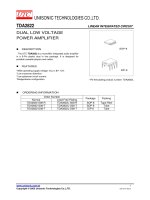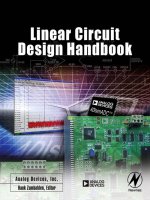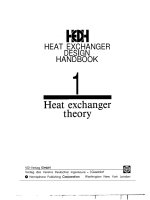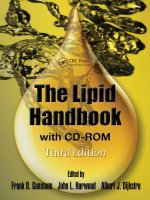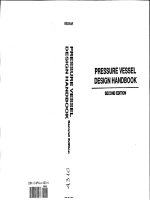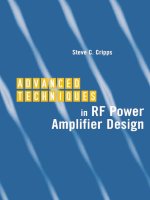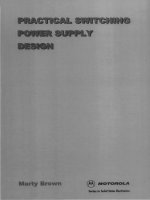self, d. (2002). audio power amplifier design handbook (3rd ed.)
Bạn đang xem bản rút gọn của tài liệu. Xem và tải ngay bản đầy đủ của tài liệu tại đây (4.69 MB, 444 trang )
Audio Power
Amplifier
Design Handbook
Audio Power
Amplifier
Design Handbook
Third edition
Douglas Self MA, MSc
Newnes
OXFORD AMSTERDAM BOSTON LONDON NEW YORK
PARIS SAN DIEGO SAN FRANCISCO SINGAPORE SYDNEY TOKYO
Newnes
An imprint of Elsevier Science
Linacre House, Jordan Hill, Oxford OX2 8DP
225 Wildwood Avenue, Woburn MA 01801-2041
First published 1996
Reprinted 1997, 1998
Second edition 2000
Reprinted 2000
Third edition 2002
Copyright © 1996, 2000, 2002, Douglas Self. All rights reserved
The right of Douglas Self to be identified as the author of this work has
been asserted in accordance with the Copyright, Designs and Patents Act
1988
No part of this publication may be reproduced in any material form (including
photocopying or storing in any medium by electronic means and whether
or not transiently or incidentally to some other use of this publication) without
the written permission of the copyright holder except in accordance with the
provisions of the Copyright, Designs and Patents Act 1988 or under the terms of
a licence issued by the Copyright Licensing Agency Ltd, 90 Tottenham Court Road,
London, England W1T 4LP. Applications for the copyright holder’s written
permission to reproduce any part of this publication should be addressed
to the publisher
British Library Cataloguing in Publication Data
A catalogue record for this book is available from the British Library
ISBN 0 7506 56360
For information on all Newnes publications visit our website at
www.newnespress.com
Composition by Genesis Typesetting, Rochester, Kent
Printed and bound in Great Britain
Contents
Synopsis vii
Preface xv
1. Introduction and general survey 1
2. History, architecture and negative feedback 30
3. The general principles of power amplifiers 60
4. The small signal stages 73
5. The output stage I 106
6. The output stage II 163
7. Compensation, slew-rate, and stability 183
8. Power supplies and PSRR 235
9. Class-A power amplifiers 255
10. Class-G power amplifiers 290
11. FET output stages 314
12. Thermal compensation and thermal dynamics 325
13. Amplifier and loudspeaker protection 370
14. Grounding and practical matters 396
15. Testing and safety 418
Index 423
v
Synopsis
Chapter 1 Introduction and general survey
The economic importance of audio amplifiers
There are no practical textbooks
Knowledge assumed
Origins and aims
The study of amplifier design
Some new findings in amplifier design
A snapshot of the technology
No inspiration from IC technology
Aimed at discrete amplifiers
Amplifiers are now designable
Misinformation in audio
Science and subjectivism
The Subjectivist position
A short history of subjectivism
The limits of hearing
Articles of faith: the tenets of subjectivism
The length of the audio chain
The implications
The reasons why
The outlook
Technical errors
The performance requirements for amplifiers
Safety
Reliability
Power output and load capability
Frequency response
Noise
Distortion
Damping factor
Absolute phase
Acronyms
vii
Synopsis
Chapter 2 History, architecture and negative
feedback
A Brief History of Power Amplifiers
Power amplifier architectures
The three-stage structure
The two-stage amplifier structure
Power amplification classes
Class-A
Class-AB
Class-B
Class-C
Class-D
Class-E
Class-F
Class-G
Class-H
Class-S
Variations on Class-B
AC and DC coupled amplifiers
The advantages of AC-coupling
The advantages of DC-coupling
Negative feedback in power amplifiers
Some common misconceptions about negative feedback
Amplifier stability and NFB
Maximising the NFB factor
Linearising before adding NFB
Chapter 3 The general principles of power
amplifiers
How a generic power amplifier really works
The advantages of the conventional
The eight distortions
The performance of a standard power amplifier
Determining open-loop non-linearity
Direct open-loop gain measurement
The use of ‘model’ amplifiers
The concept of the Blameless amplifier
Chapter 4 The small signal stages
The role of the input stage
Three kinds of differential input stage
BJTs versus FETs for input stages
Singleton versus differential input stages
Measuring input stage distortion in isolation
viii
Synopsis
Importance of input stage balance
Use of current-mirrors
Constant-gm degeneration
Radical methods of improving linearity
Input stage cascoding
Input noise and how to reduce it
Input balance and DC offset
The input stage and the slew-rate
The voltage-amplifier stage
Measuring VAS distortion in isolation
VAS operation
VAS distortion
Linearising the VAS: active-load techniques
Enhancements to the basic VAS
The importance of voltage drive
The Balanced VAS
The VAS and the manipulation of open-Loop bandwidth
Manipulating open-loop bandwidth
Conclusions
Chapter 5 The output stage I
Classes and devices
The distortions of the output
Harmonic generation by crossover distortion
Comparing output stages
The Emitter-Follower output configuration
The Complementary-Feedback-Pair output configuration
Quasi-Complementary output stages
Output triples
Triple EF output stages
Distortion and its mechanisms
Large-signal distortion
The load-invariant concept
The LSN mechanism
Doubled output devices
Better output devices
Feedforward diodes
Trouble with triples
Loads below 4 ⍀
Better 8-⍀ performance
A practical load-invariant design
The latest findings
Summary
Crossover distortion
Switchoff distortion
ix
Synopsis
Thermal distortion: why it doesn’t exist
Thermal distortion in a power amp IC
Selecting the appropriate output stage
Closing the loop: distortion in complete amplifiers
Conclusions
Chapter 6 The output stage II
Distortion 4: non-linear loading of the VAS
Distortion 5: incorrect decouple grounding
Distortion 6: the induction of non-linear currents
Distortion 7: incorrect feedback connection point
Distortion 8: feedback capacitor distortion
A complete Class-B power amplifier
Chapter 7 Compensation, slew-rate, and stability
Compensation in general
Dominant-pole compensation
Lag compensation
Including the output-stage: inclusive Miller compensation
Nested feedback loops
Two-pole compensation
Output networks
Amplifier output impedance
Minimising amplifier output impedance
Zobel networks
Output inductors
The output inductor value
Cable effects
Crosstalk in amplifier output inductors
Conclusions
Reactive loads and speaker simulation
Resistive loads
Loudspeaker load modelling
Reactive and loudspeaker loads
Single-speaker load
Two-way speaker loads
Enhanced loudspeaker currents
Amplifier instability
HF instability
LF instability
Speed and slew-rate in audio amplifiers
The basics of amplifer slew-limiting
Slew-rate measurement techniques
Improving the slew-rate
Simulating slew-limiting
x
Synopsis
Slewing limitations in real life
Some additional complications
Further improvements and other configurations
Chapter 8 Power supplies and PSRR
Power supply technologies
Simple unregulated supplies
Linear regulated supplies
Switch-made power supplies
Design considerations for unregulated supplies
Mains transformers
Fusing and rectification
RF emissions from bridge rectifiers
Power supply-rail rejection
A design philosophy for rail rejection
Positive supply-rail rejection
Negative supply-rail rejection
Chapter 9 Class-A power amplifiers
An introduction to Class-A
Class-A configurations and efficiency
Output stages in Class-A
Quiescent current control systems
A novel quiescent current controller
A complete Class-A power amplifier
Trimodal power amplifiers
Load impedance and operating mode
Efficiency
On Trimodal biasing
Class-A/AB mode
Class-B mode
The mode-switching system
Thermal design
A complete Trimodal power amplifier
The power supply
The performance
Further possibilities
Chapter 10 Class-G power amplifiers
The principles of Class-G
Introducing series Class-G
Efficiency of Class-G
Practicalities
The biasing requirements
xi
Synopsis
The linearity issues of series Class-G
The static linearity
Practical Class-G design
Controlling small-signal distortion
The performance
Deriving a new kind of amplifier: Class-A + C
Adding two-pole compensation
Further variations on Class-G
Chapter 11 FET output stages
The characteristics of power FETs
Power FETs versus bipolar transistors (BJTs)
Insulated-Gate Bipolar Junction Transistors (IGBTs)
Power FET output stages
The FET/bipolar linearity comparison
FETs in Class-A stages
Chapter 12 Thermal compensation and thermal
dynamics
Why Class-B quiescent conditions are critical
The accuracy required
Basic thermal compensation
Assessing the bias errors
Thermal simulation
Modelling the EF output stage
Modelling the CFP output stage
The integrated absolute error criterion
Improved thermal compensation: The emitter-follower stage
Improved thermal compensation: The CFP output stage
A better CFP sensor position
A junction-temperature estimator
A junction estimator with dynamics
Conclusion
Variable-tempco bias generators
Creating a higher tempco
Ambient temperature changes
Creating a lower tempco
Current compensation
Thermal dynamics in reality
Early effect in output stages
Chapter 13 Amplifier and loudspeaker protection
Categories of amplifier protection
Semiconductor failure modes
xii
Synopsis
Overload protection
Fusing
Electronic protection
Plotting the protection locus
Simple current-limiting
Single-slope VI limiting
Dual-slope VI limiting
Simulating overload protection
Catching diodes
DC-offset protection
Fusing
Relay protection and muting output control
Distortion in output relays
Output crowbar DC protection
Protection by power-supply shutdown
Thermal protection
Powering auxiliary circuitry
Chapter 14 Grounding and practical matters
Audio Amplifier PCB design
Crosstalk
Rail induction distortion
The mounting of output devices
Single and double-sided PCBs
Power supplies
Power amplifier PCB layout details
The audio PCB layout sequence
Miscellaneous points
Amplifier grounding
Ground loops: how they work and how to deal with them
Class I and Class II
Mechanical layout and design
Convection cooling
Cooling
Mains transformers
Wiring layout
Semiconductor installation
Chapter 15 Testing and safety
Testing and fault-finding
Safety requirements
xiii
I wish to dedicate this book to my parents Russell and Evelyn, and
to all the friends and colleagues who have given me help,
information and encouragement while I was engaged in its writing.
In particular I want to acknowledge the active assistance and
collaboration of Gareth Connor in the quest for the perfect
amplifier, and the fortitude of Peter King in enduring many rambling
expositions of my latest thoughts on the subject.
xiv
Preface
The design of power amplifiers exerts a deep fascination all of its own in
both amateur and professional circles. The job they do is essentially simple,
but making a reliable high-performance circuit to do it well is surprisingly
difficult, and involves delving into all kinds of byways of electronics.
Perhaps this paradox is at the root of the enduring interest they generate.
Reliable information on power amplifier design is hard to find, but in this
book, I hope to fill at least some of that need.
It is notable how few aspects of amplifier design have received serious
scientific investigation. Much of this book is the result of my own research,
because the information required simply was not to be found in the
published literature.
In the course of my investigations, I was able to determine that power
amplifier distortion, traditionally a difficult and mysterious thing to grapple
with, was the hydra-headed amalgamation of seven or eight mechanisms,
overlaying each other and contributing to a complex result. I have evolved
ways of measuring and minimising each distortion mechanism separately,
and the result is a design methodology for making Class-B or Class-A
amplifiers with distortion performance so good that two or three years ago
it would have been regarded as impossible. The methodology gives
pleasingly reliable and repeatable results with moderate amounts of
negative feedback, and insignificant added cost. It is described and
explained in detail here.
This leads to the concept of what I have called a Blameless amplifier, which
forms a benchmark for distortion performance that varies surprisingly little,
and so forms a well-defined point of departure for more ambitious and
radical amplifier designs. The first of these I have undertaken is the Trimodal
amplifier (so-called because it can work in any of the modes A, AB and B,
as the situation requires) which is fully described in Chapter 9.
Apart from the major issue of distortion and linearity in power amplifier
design, I also cover more mundane but important matters such as reliability,
power supplies, overload and DC-protection, and so on. In addition there
xv
Preface
is unique material on reactive loading, unusual forms of compensation,
distortion produced by capacitors and fuses, and much more. I have
provided a wide and varied selection of references, so that those interested
can pursue the issues further.
Sometimes controversies arise in audio; in fact, it would be truer to say that
they have become endemic, despite a lack of hard facts on which genuine
differences of opinion might be based. Although audio power amplifiers are
in many ways straightforward in their doings, they have not escaped the
attentions of those who incline more to faith than science. In my writings,
I simply go where the facts lead me, and my experiences as an amateur
musician, my work designing professional mixing consoles, and my studies
in psychology and psychoacoustics have led me to the firm conclusion that
inexplicable influences on audio quality simply do not exist, and that any
serious book on amplifier design must start from this premise.
I have done my best to make sure that everything in this book is as correct
as theory, simulation, practical measurement and late-night worrying can
make it. The basic arguments have been validated by the production of
more than twenty thousand high-power Blameless amplifiers over the last
two years, which is perhaps as solid a confirmation as any methodology
can hope to receive. If some minor errors do remain, these are entirely
my responsibility, and when alerted I will correct them at the first
opportunity.
I hope this book may be interesting and useful to the amplifier designer and
constructor, be they amateur or professional. However, it is my fondest
wish that it may stimulate others to further explore and expand the limits of
audio knowledge.
Douglas Self
xvi
1
Introduction and general
survey
The economic importance of power amplifiers
Audio power amplifiers are of considerable economic importance. They
are built in their hundreds of thousands every year, and have a history
extending back to the 1920s. It is therefore surprising there have been so
few books dealing in any depth with solid-state power amplifier design.
The first aim of this text is to fill that need, by providing a detailed guide to
the many design decisions that must be taken when a power amplifier is
designed.
The second aim is disseminate the results of the original work done on
amplifier design in the last few years. The unexpected result of these
investigations was to show that power amplifiers of extraordinarily low
distortion could be designed as a matter of routine, without any
unwelcome side-effects, so long as a relatively simple design methodology
was followed. This methodology will be explained in detail.
Assumptions
To keep its length reasonable, a book such as this must assume a basic
knowledge of audio electronics. I do not propose to plough through the
definitions of frequency response, THD and signal-to-noise ratio; this can
be found anywhere. Commonplace facts have been ruthlessly omitted
where their absence makes room for something new or unusual, so this is
not the place to start learning electronics from scratch. Mathematics has
been confined to a few simple equations determining vital parameters such
as open-loop gain; anything more complex is best left to a circuit simulator
you trust. Your assumptions, and hence the output, may be wrong, but at
least the calculations in-between will be correct
1
Audio Power Amplifier Design Handbook
The principles of negative feedback as applied to power amplifiers are
explained in detail, as there is still widespread confusion as to exactly how
it works.
Origins and aims
The core of this book is based on a series of eight articles originally
published in Electronics World as ‘Distortion In Power Amplifiers’. This
series was primarily concerned with distortion as the most variable feature
of power amplifier performance. You may have two units placed side by
side, one giving 2% THD and the other 0.0005% at full power, and both
claiming to provide the ultimate audio experience. The ratio between the
two figures is a staggering 4000:1, and this is clearly a remarkable state of
affairs. One might be forgiven for concluding that distortion was not a very
important parameter. What is even more surprising to those who have not
followed the evolution of audio over the last two decades is that the more
distortive amplifier will almost certainly be the more expensive. I shall deal
in detail with the reasons for this astonishing range of variation.
The original series was inspired by the desire to invent a new output stage
that would be as linear as Class-A, without the daunting heat problems. In
the course of this work it emerged that output stage distortion was
completely obscured by non-linearities in the small-signal stages, and it
was clear that these distortions would need to be eliminated before any
progress could be made. The small-signal stages were therefore studied in
isolation, using model amplifiers with low-power and very linear Class-A
output stages, until the various overlapping distortion mechanisms had
been separated out. It has to be said this was not an easy process. In each
case there proved to be a simple, and sometimes well-known cure, and
perhaps the most novel part of my approach is that all these mechanisms
are dealt with, rather than one or two, and the final result is an amplifier
with unusually low distortion, using only modest and safe amounts of
global negative feedback.
Much of this book concentrates on the distortion performance of amplifiers.
One reason is that this varies more than any other parameter – by up to a
factor of a thousand. Amplifier distortion was until recently an enigmatic
field – it was clear that there were several overlapping distortion
mechanisms in the typical amplifier, but it is the work reported here that
shows how to disentangle them, so they may be separately studied and
then with the knowledge thus gained, minimised.
I assume here that distortion is a bad thing, and should be minimised; I
make no apology for putting it as plainly as that. Alternative philosophies
hold that as some forms of non-linearity are considered harmless or even
euphonic, they should be encouraged, or at any rate not positively
discouraged. I state plainly that I have no sympathy with the latter view; to
2
Introduction and general survey
my mind the goal is to make the audio path as transparent as possible. If
some sort of distortion is considered desirable, then surely the logical way
to introduce it is by an outboard processor, working at line level. This is not
only more cost-effective than generating distortion with directly-heated
triodes, but has the important attribute that it can be switched off. Those
who have brought into being our current signal-delivery chain, i.e. mixing
consoles, multi-track recorders, CDs, have done us proud in the matter of
low distortion, and to wilfully throw away this achievement at the very last
stage strikes me as curious at best.
In this book I hope to provide information that is useful to all those
interested in power amplifiers. Britain has a long tradition of small and very
small audio companies, whose technical and production resources may not
differ very greatly from those available to the committed amateur. I hope
this volume will be of service to both.
I have endeavoured to address both the quest for technical perfection –
which is certainly not over, as far as I am concerned – and also the
commercial necessity of achieving good specifications at minimum cost.
The field of audio is full of statements that appear plausible but in fact have
never been tested and often turn out to be quite untrue. For this reason I
have confined myself as closely as possible to facts that I have verified
myself. This volume may therefore appear somewhat idiosyncratic in
places; for example FET output stages receive much less coverage than
bipolar ones because the conclusion appears to be inescapable that FETs
are both more expensive and less linear; I have therefore not pursued the
FET route very far. Similarly, most of my practical design experience has
been on amplifiers of less than 300 W power output, and so heavy-duty
designs for large-scale PA work are also under-represented. I think this is
preferable to setting down untested speculation.
The study of amplifier design
Although solid-state amplifiers have been around for some forty years, it
would be a great mistake to assume that everything possible is known
about them. In the course of my investigations I discovered several matters
which, not appearing in the technical literature, appear to be novel, at least
in their combined application:
The need to precisely balance the input pair to prevent second-harmonic
generation.
The demonstration of how a beta-enhancement transistor increases the
linearity and reduces the collector impedance of the Voltage-Amplifier
Stage.
An explanation of why BJT output stages always distort more into 4 ⍀
than 8 ⍀.
3
Audio Power Amplifier Design Handbook
In a conventional BJT output stage, quiescent current as such is of little
importance. What is crucial is the voltage between the transistor
emitters.
Power FETs, though for many years touted as superior in linearity, are
actually far less linear than bipolar output devices.
In most amplifiers, the major source of distortion is not inherent in the
amplifying stages, but results from avoidable problems such as induction
of supply-rail currents and poor power-supply rejection.
Any number of oscillograms of square-waves with ringing have been
published that claim to be the transient response of an amplifier into a
capacitive load. In actual fact this ringing is due to the output inductor
resonating with the load, and tells you precisely nothing about amplifier
stability.
The above list is by no means complete.
As in any developing field, this book cannot claim to be the last word on
the subject; rather it hopes to be a snapshot of the state of understanding at
this time. Similarly, I certainly do not claim that this book is fully
comprehensive; a work that covered every possible aspect of every
conceivable power amplifier would run to thousands of pages. On many
occasions I have found myself about to write: ‘It would take a whole book
to deal properly with ’ Within a limited compass I have tried to be
innovative as well as comprehensive, but in many cases the best I can do
is to give a good selection of references that will enable the interested to
pursue matters further. The appearance of a reference means that I consider
it worth reading, and not that I think it to be correct in every respect.
Sometimes it is said that discrete power amplifier design is rather
unenterprising, given the enormous outpouring of ingenuity in the design of
analogue ICs. Advances in op-amp design would appear to be particularly
relevant. I have therefore spent some considerable time studying this
massive body of material and I have had to regretfully conclude that it is
actually a very sparse source of inspiration for new audio power amplifier
techniques; there are several reasons for this, and it may spare the time of
others if I quickly enumerate them here:
A large part of the existing data refers only to small-signal MOSFETs,
such as those used in CMOS op-amps, and is dominated by the ways in
which they differ from BJTs, for example in their low transconductance.
CMOS devices can have their characteristics customised to a certain
extent by manipulating the width/length ratio of the channel.
In general, only the earlier material refers to BJT circuitry, and then it is
often mainly concerned with the difficulties of making complementary
circuitry when the only PNP transistors available are the slow lateral
kind with limited beta and poor frequency response.
Many of the CMOS op-amps studied are transconductance amplifiers,
i.e. voltage-difference-in, current out. Compensation is usually based on
4
Introduction and general survey
putting a specified load capacitance across the high-impedance output.
This does not appear to be a promising approach to making audio power
amplifiers.
Much of the op-amp material is concerned with the common-mode
performance of the input stage. This is pretty much irrelevant to power
amplifier design.
Many circuit techniques rely heavily on the matching of device
characteristics possible in IC fabrication, and there is also an emphasis
on minimising chip area to reduce cost.
A good many IC techniques are only necessary because it is (or was)
difficult to make precise and linear IC resistors. Circuit design is also
influenced by the need to keep compensation capacitors as small as
possible, as they take up a disproportionately large amount of chip area
for their function.
The material here is aimed at all audio power amplifiers that are still
primarily built from discrete components, which can include anything from
10 W mid-fi systems to the most rarefied reaches of what is sometimes
called the ‘high end’, though the ‘expensive end’ might be a more accurate
term. There are of course a large number of IC and hybrid amplifiers, but
since their design details are fixed and inaccessible they are not dealt with
here. Their use is (or at any rate should be) simply a matter of following the
relevant application note. The quality and reliability of IC power amps has
improved noticeably over the last decade, but low distortion and high
power still remain the province of discrete circuitry, and this situation
seems likely to persist for the foreseeable future.
Power amplifier design has often been treated as something of a black art,
with the implication that the design process is extremely complex and its
outcome not very predictable. I hope to show that this need no longer be
the case, and that power amplifiers are now designable – in other words it
is possible to predict reasonably accurately the practical performance of a
purely theoretical design. I have done a considerable amount of research
work on amplifier design, much of which appears to have been done for
the first time, and it is now possible for me to put forward a design
methodology that allows an amplifier to be designed for a specific
negative-feedback factor at a given frequency, and to a large extent allows
the distortion performance to be predicted. I shall show that this
methodology allows amplifiers of extremely low distortion (sub 0.001% at
1 kHz) to be designed and built as a matter of routine, using only modest
amounts of global negative feedback.
Misinformation in audio
Few fields of technical endeavour are more plagued with errors, mis-
statements and confusion than audio. In the last twenty years the rise of
controversial and non-rational audio hypotheses, gathered under the title
5
Audio Power Amplifier Design Handbook
Subjectivism has deepened these difficulties. It is commonplace for hi-fi
reviewers to claim that they have perceived subtle audio differences which
cannot be related to electrical performance measurements. These claims
include the alleged production of a ‘three-dimensional sound-stage and
protests that the rhythm of the music has been altered’; these statements are
typically produced in isolation, with no attempt made to correlate them to
objective test results. The latter in particular appears to be a quite
impossible claim.
This volume does not address the implementation of Subjectivist notions,
but confines itself to the measurable, the rational, and the repeatable. This
is not as restrictive as it may appear; there is nothing to prevent you using
the methodology presented here to design an amplifier that is technically
excellent, and then gilding the lily by using whatever brands of expensive
resistor or capacitor are currently fashionable, and doing the internal wiring
with cable that costs more per metre than the rest of the unit put together.
Such nods to Subjectivist convention are unlikely to damage the real
performance; this is however not the case with some of the more damaging
hypotheses, such as the claim that negative feedback is inherently harmful.
Reduce the feedback factor and you will degrade the real-life operation of
almost any design.
Such problems arise because audio electronics is a more technically
complex subject than it at first appears. It is easy to cobble together some
sort of power amplifier that works, and this can give people an altogether
exaggerated view of how deeply they understand what they have created.
In contrast, no-one is likely to take a ‘subjective’ approach to the design of
an aeroplane wing or a rocket engine; the margins for error are rather
smaller, and the consequences of malfunction somewhat more serious.
The Subjectivist position is of no help to anyone hoping to design a good
power amplifier. However, it promises to be with us for some further time
yet, and it is appropriate to review it here and show why it need not be
considered at the design stage. The marketing stage is of course another
matter.
Science and subjectivism
Audio engineering is in a singular position. There can be few branches of
engineering science rent from top to bottom by such a basic division as the
Subjectivist/rationalist dichotomy. Subjectivism is still a significant issue in
the hi-fi section of the industry, but mercifully has made little headway in
professional audio, where an intimate acquaintance with the original
sound, and the need to earn a living with reliable and affordable
equipment, provides an effective barrier against most of the irrational
influences. (Note that the opposite of Subjectivist is not ‘Objectivist’. This
term refers to the followers of the philosophy of Ayn Rand.)
6
Introduction and general survey
Most fields of technology have defined and accepted measures of
excellence; car makers compete to improve MPH and MPG; computer
manufacturers boast of MIPs (millions of instructions per second) and so on.
Improvement in these real quantities is regarded as unequivocally a step
forward. In the field of hi-fi, many people seem to have difficulty in
deciding which direction forward is.
Working as a professional audio designer, I often encounter opinions
which, while an integral part of the Subjectivist offshoot of hi-fi, are treated
with ridicule by practitioners of other branches of electrical engineering.
The would-be designer is not likely to be encouraged by being told that
audio is not far removed from witchcraft, and that no-one truly knows what
they are doing. I have been told by a Subjectivist that the operation of the
human ear is so complex that its interaction with measurable parameters
lies forever beyond human comprehension. I hope this is an extreme
position; it was, I may add, proffered as a flat statement rather than a basis
for discussion.
I have studied audio design from the viewpoints of electronic design,
psychoacoustics, and my own humble efforts at musical creativity. I have
found complete scepticism towards Subjectivism to be the only tenable
position. Nonetheless, if hitherto unsuspected dimensions of audio quality
are ever shown to exist, then I look forward keenly to exploiting them. At
this point I should say that no doubt most of the esoteric opinions are held
in complete sincerity.
The Subjectivist position
A short definition of the Subjectivist position on power amplifiers might
read as follows:
Objective measurements of an amplifier’s performance are unimportant
compared with the subjective impressions received in informal listening
tests. Should the two contradict the objective results may be
dismissed.
Degradation effects exist in amplifiers that are unknown to orthodox
engineering science, and are not revealed by the usual objective tests.
Considerable latitude may be employed in suggesting hypothetical
mechanisms of audio impairment, such as mysterious capacitor short-
comings and subtle cable defects, without reference to the plausibility of
the concept, or the gathering of objective evidence of any kind.
I hope that this is considered a reasonable statement of the situation;
meanwhile the great majority of the paying public continue to buy
conventional hi-fi systems, ignoring the expensive and esoteric high-end
sector where the debate is fiercest.
It may appear unlikely that a sizeable part of an industry could have set off
in a direction that is quite counter to the facts; it could be objected that
7
Audio Power Amplifier Design Handbook
such a loss of direction in a scientific subject would be unprecedented. This
is not so.
Parallel events that suggest themselves include the destruction of the study
of genetics under Lysenko in the USSR
[1]
. Another possibility is the study of
parapsychology, now in deep trouble because after some 100 years of
investigation it has not uncovered the ghost (sorry) of a repeatable
phenomenon
[2]
. This sounds all too familiar. It could be argued that
parapsychology is a poor analogy because most people would accept that
there was nothing there to study in the first place, whereas nobody would
assert that objective measurements and subjective sound quality have no
correlation at all; one need only pick up the telephone to remind oneself
what a 4 kHz bandwidth and 10% or so THD sounds like.
The most starting parallel I have found in the history of science is the
almost-forgotten affair of Blondlot and the N-rays
[3]
. In 1903, Rene
Blondlot, a respected French physicist, claimed to have discovered a new
form of radiation he called ‘N-rays’. (This was shortly after the discovery of
X-rays by Roentgen, so rays were in the air, as it were.) This invisible
radiation was apparently mysteriously refracted by aluminium prisms; but
the crucial factor was that its presence could only be shown by subjective
assessment of the brightness of an electric arc allegedly affected by N-rays.
No objective measurement appeared to be possible. To Blondlot, and at
least fourteen of his professional colleagues, the subtle changes in
brightness were real, and the French Academy published more than a
hundred papers on the subject.
Unfortunately N-rays were completely imaginary, a product of the
‘experimenter-expectancy’ effect. This was demonstrated by American
scientist Robert Wood, who quietly pocketed the aluminium prism during
a demonstration, without affecting Bondlot’s recital of the results. After this
the N-ray industry collapsed very quickly, and while it was a major
embarrassment at the time, it is now almost forgotten.
The conclusion is inescapable that it is quite possible for large numbers of
sincere people to deceive themselves when dealing with subjective
assessments of phenomena.
A short history of subjectivism
The early history of sound reproduction is notable for the number of times
that observers reported that an acoustic gramophone gave results indis-
tinguishable from reality. The mere existence of such statements throws
light on how powerfully mind-set affects subjective impressions. Interest in
sound reproduction intensified in the post-war period, and technical
standards such as DIN 45–500 were set, though they were soon criticised
as too permissive. By the late 1960s it was widely accepted that the
requirements for hi-fi would be satisfied by ‘THD less than 0.1%, with no
8
Introduction and general survey
significant crossover distortion, frequency response 20–20 kHz, and as
little noise as possible, please’. The early 1970s saw this expanded to
include slew-rates and properly behaved overload protection, but the
approach was always scientific and it was normal to read amplifier reviews
in which measurements were dissected but no mention made of listening
tests.
Following the growth of subjectivism through the pages of one of the
leading Subjectivist magazines (Hi-Fi News), the first intimation of what
was to come was the commencement of Paul Messenger’s column
Subjective Sounds in September 1976, in which he said: ‘The assessment
will be (almost) purely subjective, which has both strengths and weak-
nesses, as the inclusion of laboratory data would involve too much time
and space, and although the ear may be the most fallible, it is also the most
sensitive evaluation instrument.’ Subjectivism as expedient rather than
policy. Significantly, none of the early instalments contained references to
amplifier sound. In March 1977, an article by Jean Hiraga was published
vilifying high levels of negative feedback and praising the sound of an
amplifier with 2% THD. In the same issue, Paul Messenger stated that a
Radford valve amplifier sounded better than a transistor one, and by the
end of the year the amplifier-sound bandwagon was rolling. Hiraga
returned in August 1977 with a highly contentious set of claims about
audible speaker cables, and after that no hypothesis was too unlikely to
receive attention.
The limits of hearing
In evaluating the Subjectivist position, it is essential to consider the known
abilities of the human ear. Contrary to the impression given by some
commentators, who call constantly for more psychoacoustical research, a
vast amount of hard scientific information already exists on this subject,
and some of it may be briefly summarised thus:
The smallest step-change in amplitude that can be detected is about
0.3 dB for a pure tone. In more realistic situations it is 0.5 to 1.0 dB. This
is about a 10% change
[4]
.
The smallest detectable change in frequency of a tone is about 0.2% in
the band 500 Hz–2 kHz. In percentage terms, this is the parameter for
which the ear is most sensitive
[5]
.
The least detectable amount of harmonic distortion is not an easy figure
to determine, as there is a multitude of variables involved, and in
particular the continuously varying level of programme means that the
level of THD introduced is also dynamically changing. With mostly low-
order harmonics present the just-detectable amount is about 1%, though
crossover effects can be picked up at 0.3%, and probably lower. There
is certainly no evidence that an amplifier producing 0.001% THD
sounds any cleaner than one producing .005%
[6]
.
9
